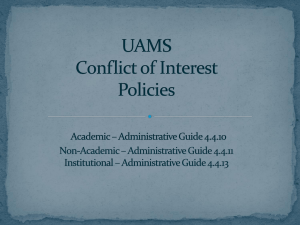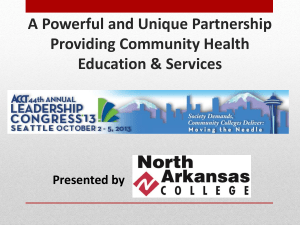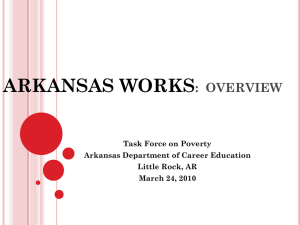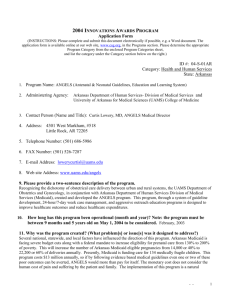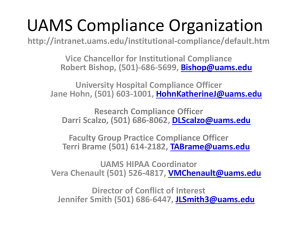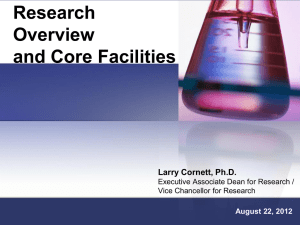- Arkansas State University
advertisement
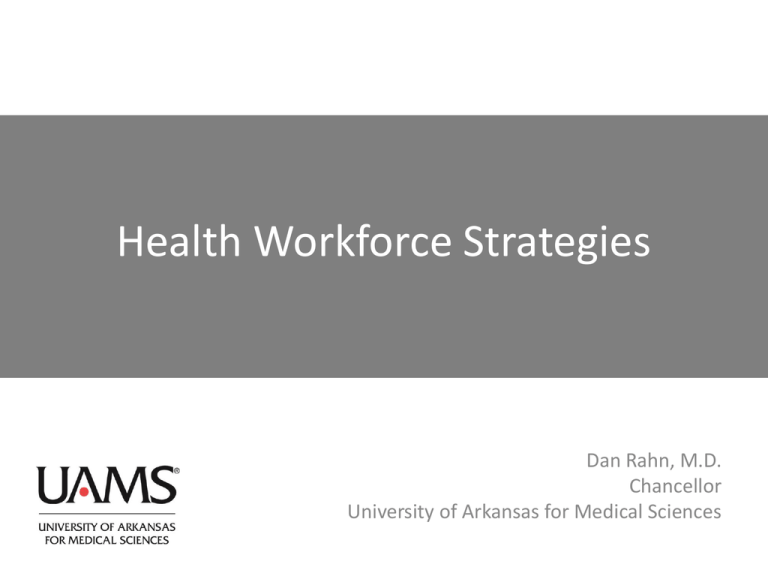
Health Workforce Strategies Dan Rahn, M.D. Chancellor University of Arkansas for Medical Sciences Health System Transformation to Achieve the Triple Aim • Higher Quality Health Care • Better Patient Experience • Lower Cost Arkansas’s Strategy for Health System Transformation • Insurance expansion so that everyone is in the system • Payment Improvement Initiative to curb rising costs and improve quality • Accelerate the use of health information technology • Work Force Strategic Plan to meet the needs of everyone in society Physician Work force Initiatives must be considered in the context of all components of health system transformation Work Force Strategic Plan - 2012 • Co-chaired with Dr. Paul Halverson, former Arkansas State Health Department Director • Broad stakeholder involvement • Final report presented to and accepted by Gov. Beebe and provided to all members of General Assembly • Three broad goals and 38 specific recommendations Goals • Goal 1: Support the implementation of and transition to team-based care that is patientcentered, coordinated, evidence-based and efficient (17 specific recommendations) • Goal 2: Enhance and increase the use of health information technology (10 recommendations) • Goal 3: Increase the supply and improve the equitable distribution of primary care providers (11 recommendations) Goal #3 Recommendations • Recruit more diverse students into health professions, especially bi- or multilingual students. • Increase funding to support nursing and PA education with additional faculty, student loan or payback programs, etc. • Expand number of graduate medical education residency slots in primary and preventive care, especially those dedicated to rural practice. • Establish the Arkansas Rural Scholars Program • Increase collaboration among two- and four-year colleges to increase access to and quality of education and training for health professions. Goal #3 Recommendations • Expand strategies to provide longitudinal clinical experiences in primary care for medical students and enhance incentives and recognition for teaching primary care for all health care professions. • Strengthen primary care leadership curricula in primary care education, residencies, and preceptorships. • Enhance outreach to educate guidance counselors and career coaches about opportunities for students to enter health professions. • Strengthen education in science, technology, engineering, and math (STEM) by strengthening curricula at all levels. • Develop more effective strategies to fill J-1 visa waiver slots and provide enhanced support for integration of international medical graduates into rural communities • All state boards responsible for licensing health professionals should implement policies to reduce complexity and decrease licensing time for qualified applicants. Estimate of current shortage of Primary care physicians • Blue and You Foundation grant estimate: Shortage of 360 physicians but if distribution were balanced and APNs and PAs are included the shortage decreases to 138. (2013) • Regional Program estimate based on statewide survey of entities looking to recruit new primary care physicians: 511. • The shortage of specialty physicians is significant but less than the shortage of primary care providers. • These estimates are based on current model of care. UAMS Initiatives • Medical school enrollment increased from 150 to 174 (2006) • Established Northwest Arkansas Campus (2006-2007) • 30 new family medicine residency slots through Regional Programs (grant funded with time limit) added from 2010 to 2013. UAMS currently has 169 family medicine residency positions around state through College of Medicine and regional programs • New psychiatry residency program in NW Arkansas (2009) • New PA program at UAMS, 26 students per year (2013) • New UAMS DNP program (20 students per year), 3 other programs in state. (2013) • New internal medicine residency program through consortium arrangement in NW Arkansas (in development) UAMS Experience • UAMS graduates who are retained in state to practice: 58% (3rd nationally). • Physicians retained in state from graduate medical education programs: 57% (6th nationally) • Physicians who have graduated from UAMS and completed a residency in Arkansas: 80% stay in Arkansas to practice (2nd nationally) • All residency programs in Arkansas are sponsored by the UAMS College of Medicine and UAMS Regional Programs with support from major educational partners • Average medical student debt at graduation - $160,224 • UAMS Annual tuition and fees - $26,694 Regional Programs’ Impact on Physician Workforce in Arkansas Regional Programs’ Impact on Physician Workforce in Arkansas Conclusion / Recommendations • Many initiatives underway to address ways to transform Arkansas’ health system to achieve the triple aim. • Current programs are highly successful (among the best in the nation) in tracking physicians into practice in Arkansas. • The primary bottle neck in increasing physician work force is limitation in residency slots and funding. It costs $160,000 per year to fund one family medicine residency position after clinical income has been taken into account. Conclusion / Recommendations • Fund expansion of GME at the state level with funding focused on meeting highest needs in Arkansas. • Arkansas has a shortage of physicians (both primary care and specialty care) and a highly significant mal-distribution problem. Focusing on one issue (like medical student enrollment) without a policy framework that addresses all of the issues is unlikely to have a meaningful impact on population health outcomes. Conclusion / Recommendations • Stay the course with insurance expansion; spread of electronic health information infrastructure, payment improvement initiative. • Promote licensure strategies that enable all members of the health care team to function at the top of their training and licensure. • Create a mechanism at the state level to ensure that educational programs are focused on producing graduates who are prepared to meet needs in Arkansas and to ensure that the recommendations of the Health Professions Work Force Strategic Plan are implemented. Conclusion / Recommendations • Provide funding for continuation of expanded Family Medicine residencies when federal funding runs out (10 slots per year, 30 total slots) and for two new rural training track Family Medicine residencies in Helena and Batesville (total of 6 additional slots per year for the two proposed programs, 18 total slots). • Modernize the rural scholarship program.
